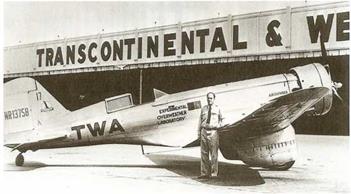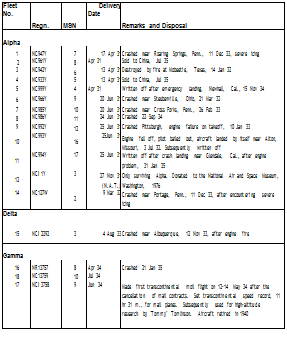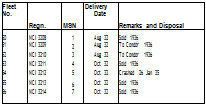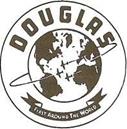Douglas DC-2
14 seats » 190 mph
|
|
the unique douglas вс-в
|
One of the early DC-2s poses for the camera. |
Tine Douglas DC-1
Only nine months after the $125,000 contract was signed, the Douglas DC-1 made its first flight on 1 July 1933, and was delivered to T. W.A. On 13 September. Jack Frye and Paul Richter flew it to Kansas City, 1,450 miles, averaging 205 mph. The airline operated the unique DC-1 for a few years, even on a few scheduled services, then it was sold to Howard Hughes in January 1936. It eventually passed to Lord Forbes in England, and finished up as a military transport during the Spanish Civil War in 1938. It crashed at Malaga in December, 1940.
The Douglas DC-2
The DC-1 had 12 seats, two more than the 247’s 10; but T. W.A. and Douglas quickly realized that by adding two more feet to the fuselage, this could be improved to 14. The resulting Douglas DC-2 first flew on 11 May 1934, went into service one week later, and the world of airlines was never the same again. It chased the 247s off the main-line U. S. airways, and when, on 1 August 1934, T. W.A. introduced it on the transcontinental “Sky Chief’ service, Jack Frye was more than vindicated in his vigorous initiative. A new era of airline service began, and as early as September, the Ford Tri-Motors were retired, to be used as freighters, or, in one unusual case, to be used as a floatplane ferry service in New York (page 44).
 |



The Northrop Alpha
Jack Northrop left Lockheed, and started his own company, at El Segundo, California, to build his first high-speed aircraft, which incorporated all-metal construction, stressed skin for the wings, and a monocoque fuselage, together with other aerodynamic improvements, such as engine cowling and wing fillets. The main objective was to save weight; but it also improved the strength; and Northrop’s innovations became standard practice. T. W.A. introduced the Northrop Alpha in April 1931. It was a beautiful aircraft, and used only for mail. As indicated in the table below, it must have been difficult for the pilots to handle.
The Lockheed Orion
The wooden Vega (see page 36) was quickly superseded by the metal Lockheed Orion, the first airliner in the world to exceed 200 mph. It was welcomed especially by airlines that competed with the Ford operators, and captured the public imagination with the publicity value of speed.
The Orion was the first aircraft to employ flaps, to reduce speed on descent and landing. Nevertheless, its survival rate was not as good as the new generations of multiengined all-metal Douglas and Boeing modern airliners.
The Consolidated Fleetster
Also appearing in the early 1930s was the neat Consolidated Fleetster, a high-winged monoplane, with clean lines and a speed of 150 mph. But it carried only six passengers, and was used sparingly by T. W.A. Like the Condor, it was recognizably, in the light of the Boeing 247 and Douglas DC-2 that came on the scene in 1933-34, the last of the generation of airplanes that had been outpaced by the explosive growth of air transport in the early 1930s.
Swan Song
The use of single-engined transport airplanes ended quite abruptly. Their record was not encouraging; and the conditions of the McNary-Watres Act ensured their speedy retirement front the commercial airways.
NORTHROP FLEET


![]()
 “Tommy” Tomlinson, one of the great experimental test pilots of the 1930s,
“Tommy” Tomlinson, one of the great experimental test pilots of the 1930s,
is seen here with the Northrop Gamma which he used to demonstrate
“over-the-weather” flying. This led to the introduction of pressurized
airliners, the first 307s (see page 44).
|
|
In contrast with Northrop’s low wing and Lockheed’s high wing design,
Ruben Fleet’s was unusual. At least the pilot had a good view.













